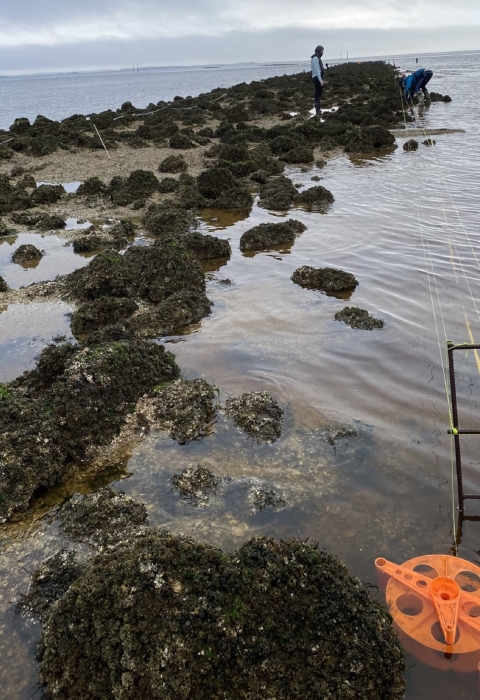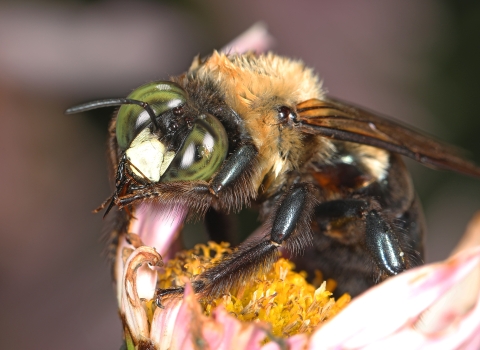Cedar Key, Florida – Brad Ennis runs the airboat over the low-tide mudflats and between the barrier islands protecting the Lower Suwannee National Wildlife Refuge. A fat raccoon traipses among clumps of cordgrass. Fog limits Gulf of Mexico visibility to 100 yards.
“It’s been worse,” Ennis says.
It’s supposed to lift by 10 a.m., three hours away. By then peak low tide will have come and gone and Ennis, with his band of University of Florida researchers, will have completed a morning’s work counting oysters on Lone Cabbage Reef.
They arrive a few minutes later at a barely visible outcropping, drop anchor and set up a 22-meter-long transect atop the limestone-and-shell ridge. They will repeat the task five times this morning, all the while racing the tides.
Their work is critically important. Restoring the reef – one of the largest in the Gulf – might resurrect the moribund oyster industry along Florida’s Big Bend. It could bolster fresh water levels in Suwannee Sound to the benefit of the many above- and below-water species that depend on a healthy mix of salt and fresh water.
The multi-million dollar Lone Cabbage Reef project could also serve as a restoration template for the entire oyster-depleted Gulf. And, a restored reef might mitigate the ravages of a warming world with its rising seas and ferocious storms that hammer the coast.
“Here you go. We’ve got some pretty good oysters right here,” says Ennis, the project’s research coordinator, handling a football-sized mollusk cluster on the reef’s southern edge. “I think, on the whole, what we’re doing is working. I go by the numbers and the historical data and I see an increase in oysters growing on the reef.”
Nobody, though, dares declare victory, not in a corner of the Gulf that witnessed an 88 percent decline in oyster reefs in less than 30 years. And not with a dwindling, and unpredictable, amount of freshwater flowing from the Suwannee River into the estuary.
“We’re at a tipping point,” says Peter Frederick, a newly retired research professor at the university who cofounded the restoration project a decade ago with colleagues Bill Pine and Leslie Sturmer. “We have fished out not just the oysters, but their essential substrate that supports them too. We’re replenishing both now. Ultimately, the solution is to get more freshwater. But there are many competing demands for that water.”
A reef in decline
The Big Bend area, stretching north from Cedar Key to Apalachicola, is a sparsely populated, wildlife-rich Florida gem. It’s the largest stretch of undeveloped coastline in the Lower 48. It’s filled with state and federally protected parks and refuges, saltwater marshes, barrier islands and hardwood forests.
The un-dammed Suwannee River supplies the fresh water that turns the northeast corner of the Gulf into a pantry of plenty for many rare and protected species including frosted flatwood salamanders, swallowtail kites, piping plovers, American oystercatchers, Gulf sturgeon and West Indian manatees. Commercial and recreational fishing – redfish, seatrout, clams, oysters – abound in the Suwannee Sound.
Or they used to. Oystering, once abundant, has all but dried up, just as it has in Apalachicola, Alabama and Texas. Locals would walk Lone Cabbage Reef at low tide and fill sacks full before the tide rolled back in.
“Anecdotally, the oysters are harder to come by,” says Frederick. “There used to be a rule of thumb: the guy in the front of the boat would tong oysters into a tray where the guy culling them would throw the good ones over his shoulder into a bucket and the rest back into the water. If you had one oyster in the air at all times you were doing pretty well. No one’s had oysters in the air for a long time.”
Gulf-wide, as much as 80 percent of the oyster reefs have suffered dramatic loss of substrate, the limestone rock base they grow upon. Reef lengths have shortened while the gaps between them have widened. Lone Cabbage’s height, too, would shrink several inches each year. Once reefs lose their covering of oyster shells they disintegrate into sandbars unsuitable for oyster growth.
The mollusks aren’t the only victims: other shellfish, small fish and plankton that depend upon the reefs as nurseries and hideouts also disappear.
Over-harvesting, pollution, hurricanes, siltation and boat wakes typically destroy oyster reefs. At Lone Cabbage, though, the Suwannee River is likely the main culprit. Actually, the paucity of Suwannee River water is the greatest cause of the reef’s problems. The sound, and the oysters, depend upon a healthy mix of fresh and salt water.
A lower-flowing river increases the amount of salty Gulf water, tipping the fresh-salt balance in favor of parasitic diseases and predatory creatures. And an already eroded reef allows more salt water to pass into the nutrient-rich estuary.
“The reef started going away in the last 30 years because of the drought-flood cycle and more, and larger, water withdrawals upriver,” says Andrew Gude, a U.S. Fish and Wildlife Service marine biologist who manages the Lower Suwannee and Cedar Key refuges. “Once those oyster reefs eroded away, it became just a bunch of shell pieces (unable) to hold enough freshwater close to the land.”
Everybody takes a piece of the free-flowing Suwannee which begins at the Okefenokee Swamp National Wildlife Refuge and flows through mostly rural, agricultural lands. Soybean, dairy and tree farmers stick straws into the river as do pulp mills and an ever-spreading Jacksonville.
Living, dead: an inventory
Ennis, via GPS attached to his cell phone, instructs the four student interns where, precisely, to measure oyster density along the three-mile reef. The fog has lifted a bit and whole sections of reef are visible above the water line. None, though, rises higher than a couple of feet. The students tally the number of live and dead oysters in 2.5-meter increments.
Ennis, with Covid mask and blue bandana all but covering his head, picks up barnacle-encrusted chunks of limestone. He feels for openings, the oyster’s lips. If open, the oyster is dead. If sealed, it’s alive.
“Here’s a dead one right here. Here’s a live one. This one’s dead. And this one,” Ennis calls out. “Here’s a live one. And another. And another. And another.”
This particular 22-meter transect isn’t very impressive, mollusk-wise. Ennis is pleased, though, with the number of barnacles, a sure sign that a healthy reef is creating habitat for oyster spat too.
Tom Kelsch, with the National Fish and Wildlife Foundation (NFWF)f, is more effusive singing Lone Cabbage’s praises.
“I’ve been very pleased with the results,” says Kelsch, a senior vice president with the nonprofit’s Gulf Environmental Benefit Fund. “We did a public event, maybe six months after the first cultch (oyster beds) were deployed and we were already seeing spat settlement. That was very, very encouraging. I would say, in fact, that Lone Cabbage is one of the most successful, if not the most successful, oyster restoration projects we’ve funded to date.”
NFWF, which works closely with the Fish and Wildlife to conserve the nation’s lands and animals, put up $8.3 million for the restoration project. The money, appropriately, comes from financial penalties assessed against BP and Transocean for the damage caused by the 2010 Deepwater Horizon oil spill. Kelsch says the Gulf Fund is spending upward of $75 million on nine oyster restoration projects from Florida to Texas.
In 2018, local oystermen, under the guidance of the university’s Nature Coast Biological Station, plucked 3,000 bushels of live oysters from Lone Cabbage and relocated them during construction. A local quarry provided limestone boulders. Oyster shells were sprinkled an inch deep over the restored reef built to mimic Lone Cabbage’s footprint from the 1800s. Ennis and crew will survey the artificial reef for five years. This is year three.
“It’s all looking great,” professor Frederick says. “One of the objectives was to get the oysters established on a new surface and get that elevation back up where it ought to be. That’s definitely been accomplished. We’re seeing not just a high density of oysters, but some good growth and good structural complexity.”
It’s too early to determine whether the reef keeps more freshwater in the estuary. A category 5 hurricane hasn’t yet slammed the Big Bend so the reef-as-protective-barrier premise hasn’t been challenged either. And, more and more people tap the Suwannee River.
“I’m optimistic, but am I optimistic that we’re going to be able to do enough to make a long-term difference? Will we have enough fresh water to do that?” Frederick wonders. “When you work on the coast the uncertainty is just so manifest. It’s sort of like farming in the Dust Bowl.”
Estuary awakes
It’s 10 o’clock and the fog has thickened. The incoming tide nearly tops researchers’ boots. Ennis calls it a day and steers the airboat toward the Lower Suwannee refuge. Along the way, and through the mist, the estuary comes alive.
Fishermen race to a favored spot. A pelican flies low over the water. Herons, egrets and black skimmers patrol Preacher’s Cove. One, two, three red-beaked oyster catchers head for the reefs. Previously rare, they now abound on the oyster reefs, as do bald eagles.
“This is a very healthy marsh,” Ennis says.




